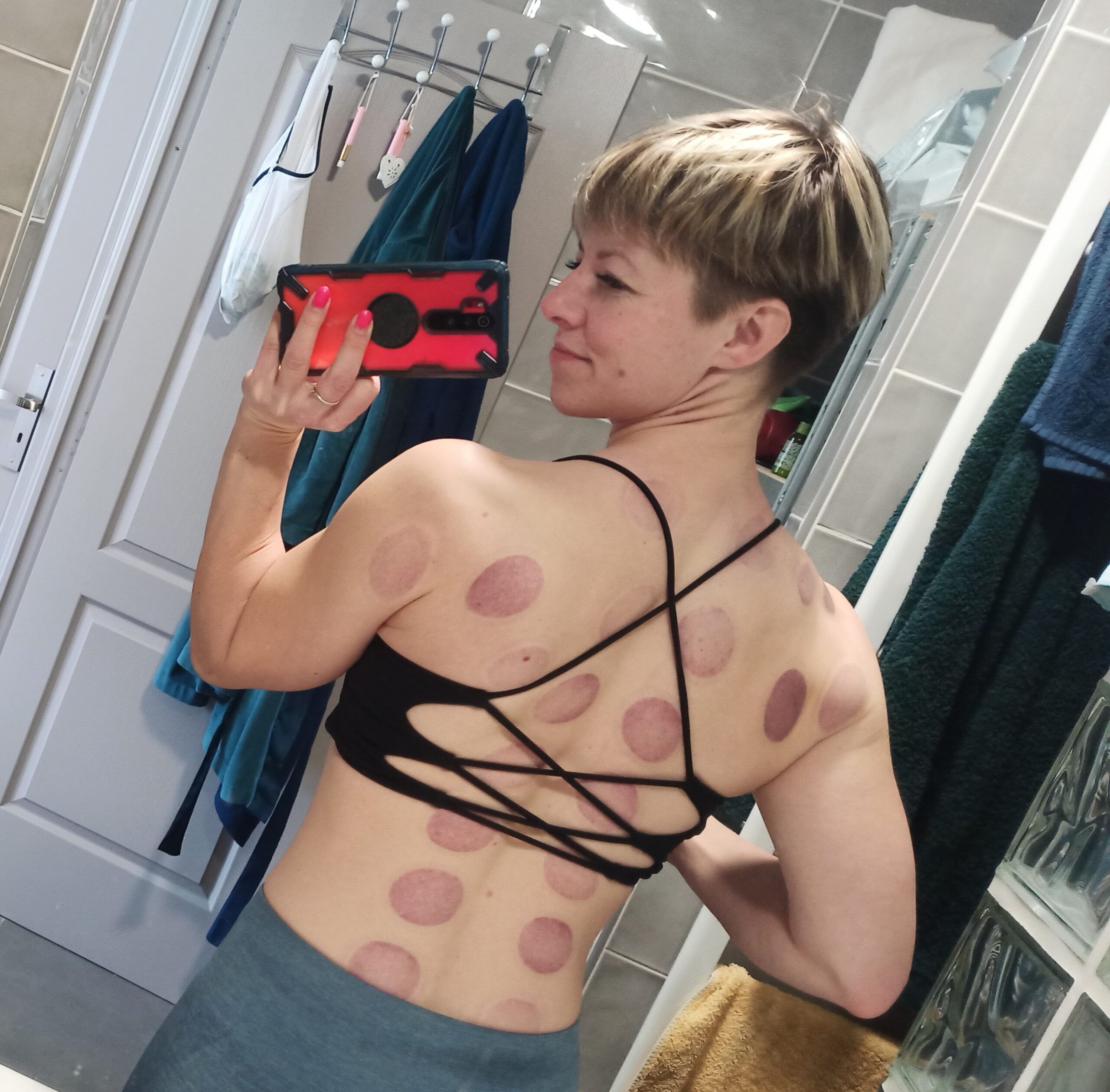So as some of you know, I have been seeing a kinesitherapist to help me with some muscle tensions in my shoulders, traps and back. One of the things he tried on me was cupping therapy.
To me cupping therapy always brings back the memories of me being ill (bronchitis) and my mom putting cups on my back. However, she was doing it not for the sake of muscle tension release, but rather to help with breaking up the mucus and help soften the cough. How effective this was, I don’t know, but it definitely was a thing. She was using the fire cupping approach (read on).
However, this time another method was used on me – the dry cupping. This basically means that the cups were placed on my tension points and air was sucked out of it manually (from the top). It creates rather weird sensations and leaves you black and blue for a week or so. The look of it is a bit dreadful – looks like you have been attacked by an octupus (see below).

The darker the spots the more tension you have in the certain spots. I carry most of my tension in the shoulders and trapeze muscles. As you can see in the picture, the lower back spots are not too pronounced.
Speaking of results – I did feel some tension release in the coming days, so I definitely can’t complain about the efficacy of this therapy. If it wasn’t for the bruising, I would probably go for this type of therapy more often.
Understanding Cupping Therapy
Cupping therapy, an ancient healing practice, has made a remarkable comeback in recent times. This unique treatment involves placing cups on the skin to create suction, stimulating blood flow, and promoting healing. The cups can be made of glass, silicone, or plastic. The vacuum effect on the skin is created through heat or suction. This gentle tug draws the skin upward into the cup, increasing blood flow to the area, believed to aid in healing and tension relief.
Types of Cupping:
- Dry Cupping: This traditional method involves placing cups on the skin and creating suction without heat. It’s great for pain relief and relaxation. This seems to be the easiest and most widely used in therapy cabinets. This is the type that I got to have recently.
- Wet Cupping: Also known as Hijama, this technique involves making small incisions on the skin before applying the cups to draw out a small amount of blood. It’s believed to detoxify the body and remove harmful substances.
- Fire Cupping: In this method, the air inside the cup is briefly heated before placing it on the skin, creating a vacuum as it cools. Fire cupping is ideal for deeper tissue penetration and addressing muscle tightness. Fire cupping was something my mom used to do for me when I had bronchitis.
Benefits of Cupping Therapy:
- Pain Relief: Cupping therapy helps alleviate muscle and joint pain by improving blood circulation and releasing tension.
- Improved Circulation: By enhancing blood flow, cupping therapy delivers oxygen and nutrients to tissues, aiding in healing and overall wellness.
- Stress Reduction: Many find cupping therapy deeply relaxing, reducing stress levels and promoting a sense of calm.
- Detoxification: Cupping therapy draws toxins to the skin’s surface, facilitating their removal and promoting detoxification.
- Enhanced Recovery: Athletes and fitness enthusiasts use cupping therapy to speed up recovery from workouts or injuries by reducing inflammation and muscle soreness.
Uses for Different Reasons:
- Musculoskeletal Pain: Cupping effectively relieves back pain, neck pain, and other muscle and joint discomforts.
- Respiratory Issues: It may help with respiratory conditions like asthma and bronchitis by improving lung function and reducing inflammation.
- Digestive Disorders: Cupping therapy can aid in digestion and alleviate symptoms of digestive issues like irritable bowel syndrome (IBS).
- Skin Conditions: Some use cupping to improve the appearance of cellulite, acne, and scars by promoting circulation and drainage.
- Mental Health: Cupping therapy supports mental health by reducing stress, anxiety, and promoting relaxation.
In essence, cupping therapy offers a holistic approach to health and wellness. The benefits range from pain relief to stress reduction. Whether used for specific ailments or as part of a general wellness routine, this therapy continues to gain popularity for its potential to promote healing and enhance overall well-being.
As always, consult with a qualified healthcare professional before trying any new therapeutic approach to ensure it’s suitable for your individual needs and health conditions.